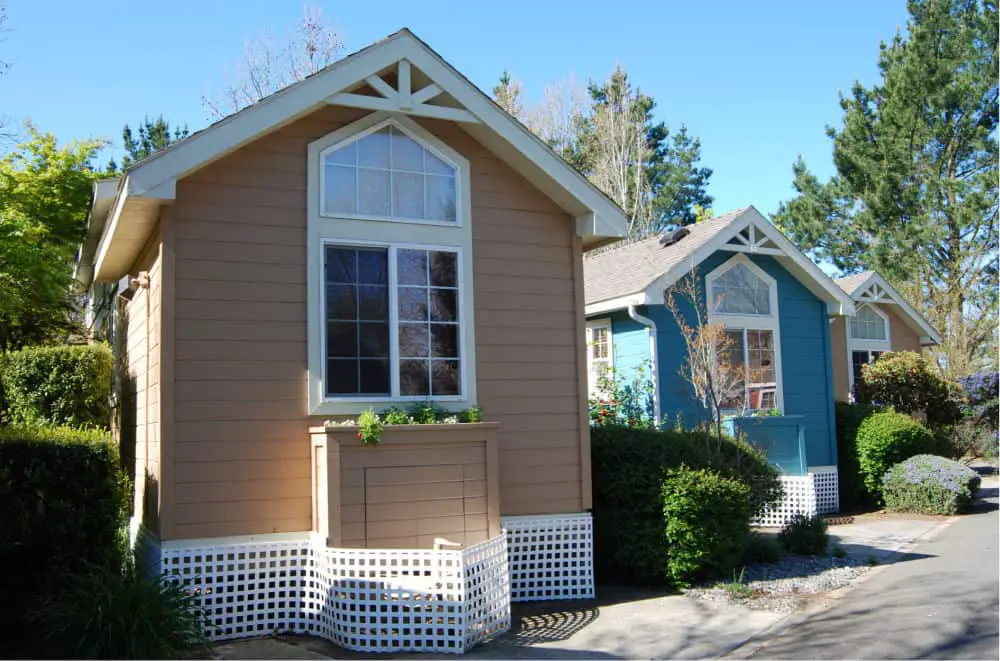Tiny houses have hit the market with a big bang. More and more people are leaning towards tiny homes as their permanent residence over RVs or the traditional two-story family homes.
But the issue with tiny houses is that they are, as described, small.
You can have a tiny house built as wide as 10 feet, although most tiny homes are the standard 8.5 feet width. However, there are some issues with creating a 10-foot wide tiny house, such as needing permits before moving, being difficult to transport, and requiring a custom trailer.
We’re going to look at the traditional size of a tiny house and any complications you may run into when trying to expand a tiny house to 10 feet wide.
Tiny House Dimensions
Most tiny houses are a standard width of 8.5′ feet (2.4384 meters), which is the maximum width legally allowed to travel on the road without needing to apply for a permit.
The length of a tiny house can range from as short as 10 feet (3.048 meters) to a length of up to 48 feet (14.6304 meters). There are also height restrictions for tiny houses. They cannot be taller than 13.5 feet (4.1148 meters), with a ceiling height of no more than 10 feet (3.048 meters).
With 8.5′ (2.4384 meters) tiny houses, you can tow your home to a new location using a 1-ton truck or even a standard pickup, without having to call in a moving expert.
Although you might prefer to use a professional if you don’t have experience with hauling large loads, as a tiny house can be tricky to relocate.
10 Feet Wide Tiny Houses
Many tiny house owners have decided to go wider than the standard 8.5′ (2.4384 meters) and opt-in for a 10 feet (3.048 meters) wide tiny house instead. A 10′ (3.048 meters) tiny home gives you two more feet of room, but it does require a trailer with wider axles.
10′ (3.048 meters) wide tiny houses are more difficult to transport and often require professional mover assistance. For this reason, many people who purchase a 10′ (3.048 meters) wide tiny house only move it once, and that’s during the initial set up.
Once you’ve set your 10 feet (3.048 meters) wide tiny house up at a location, it’s better to leave it permanently. Every time you put your 10 feet (3.048 meters) tiny house on the road, you will need to apply for a moving permit. Over time, these fees can add up to put a pretty sizeable dent in your budget.
The cost of a permit to haul an oversize load will vary by state, ranging between $14 and $30. If you want a tiny house that you can hook up to your truck and drag to a new spot on a whim, you’ll want to stick with a tiny house that’s the standard 8.5 feet (2.4384 meters).
Benefits of a 10-Foot-Wide Tiny House
There are benefits to having a 10-foot wide tiny house versus a traditional 8.5′. Let’s discuss a few reasons you want to choose a 10′ tiny house over a smaller size.
Extra Room
First of all, with a 10-foot tiny home, the two feet can give you extra room for storage, living space, or anything your mind can dream. With such a small space, you’ll appropriate all the extra room you can get.
If you’re going to be spending a lot of time in your tiny home, such as for permanent residence, you might prefer a bigger house than the standard tiny home.
Just because you’re living in a smaller space than a traditional home doesn’t mean you have to live without luxury amenities. Your tiny home can be equipped with anything you want, from an oversized kitchen to spa-quality bathrooms. You even have a laundry room and privacy.
Tiny Homes Save You Money
Tiny homes are cheaper than traditional homes, including the cost of building, and the price of your bills. Since there’s less area to cool, heat, or power, your monthly bills will be lower.
The permits you require to move your tiny home from one location to another can add extra costs. So, it would be best if you considered this when debating between a tiny oversize home and a traditional size home for frequent traveling.
Simplistic Lifestyle
Living in a tiny house can be challenging, but it can also make life simpler. Because you’re in such a confined space, there’s limited room for your stuff, so you end up getting rid of a lot of unnecessary junk you’ve collected over the years.
It’s easier to find peace when you know the important things and surround yourself with things that bring you comfort.
Tiny Homes Are Tidier
A great thing about tiny homes is that it’s simpler to keep clean. This could be a huge benefit for people who live busy lives. With an extra two feet of space, you can have more organization in your home.
Instead of wasting your limited free time cleaning, you get to enjoy your life. However, be aware that your home can start to look messy pretty quick if you don’t pick up after yourself.
Cons of Having a 10-Foot-Wide Tiny House
Most people usually choose a ten-foot tiny house when they’re looking for a home that they can set up as permanent spots. If you want a tiny house that you can use for frequent traveling, you will do better to go with a standard 8.5 foot tiny home.
Moving Can Be Difficult
Two feet (0.6096 meters) doesn’t sound like much, but it is enough to cause a tiny house to be too large to travel on highways without preparation. To move on the road, an object cannot exceed 8.5′ (2.4384 meters).
Otherwise, there isn’t enough clearance for you to pass other vehicles or obstacles on the road’s sides without hitting them. It can be time-consuming to travel a long distance with a tiny oversize home.
Risk of Damage
In narrow spaces, you can face challenges of getting damage to your house from other vehicles or structures. You may have to pull over to wait for traffic before passing through certain areas.
And many times, you will be responsible for any damages done to another person’s property by your tiny homes, such as mailboxes, fences, or vehicles.
Insurance
Insuring a tiny house can be tricky, so be sure you do your research, so you’re covered in all situations, including travel.
Permits
And before you put your 10′ tiny home on the road, you should check with your state to see if you have to apply for any permits, which you usually need.
Pricing can vary, and you may need multiple types if you’re traveling through different states. If you want to do a lot of traveling with your tiny house, it could get expensive.
In Closing
Tiny houses come in all sizes of length, but they have standard limits on the height and width. According to the standards for tiny houses, you cannot exceed 40 feet long (12.192 meters) for a total length of 65 feet (19.812 meters) including your towing vehicle), or 13.5′ (4.1148 meters) in height.
The standard width for a tiny house should not exceed 8.5 feet (2.4384 meters), as this is the widest width that can safely travel on the road without applying for a permit. It is possible to have a tiny house that’s up to 10 feet wide (3.048 meters).
However, anything over 8.5 feet (2.4384 meters) requires a permit to move, which equals higher costs if you want to use your tiny house to travel.

